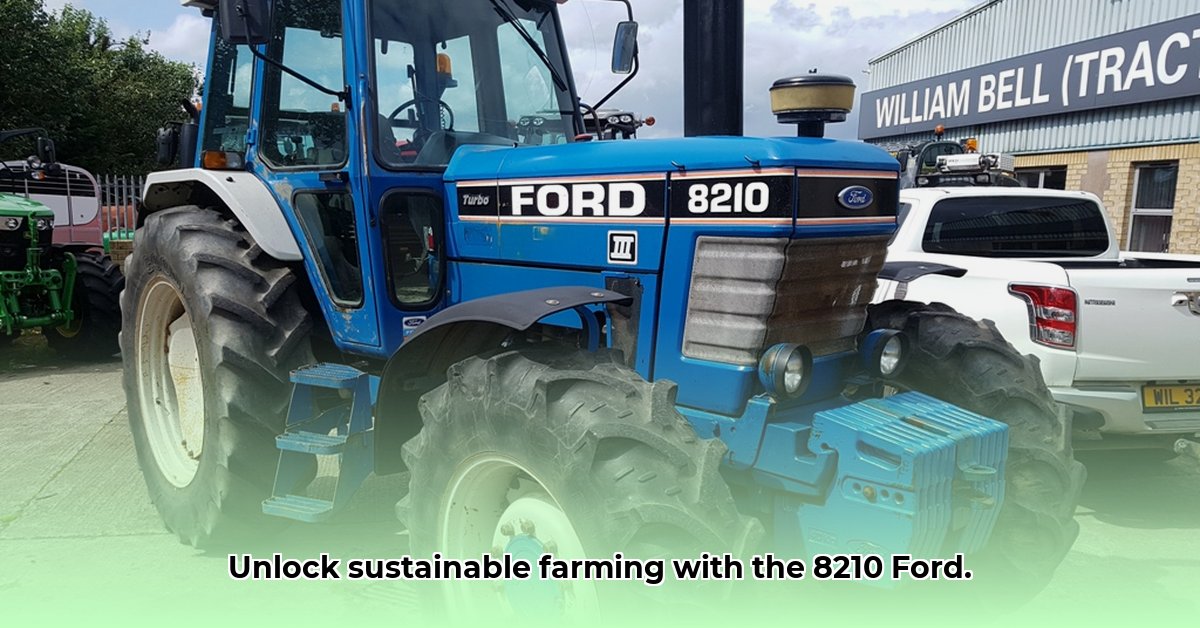
A Sustainable Farming Reality Check: The Ford 8210
The Ford 8210 tractor, a stalwart of the early 1990s, presents a compelling case study in sustainable agriculture. Released in 1991 with a 110-horsepower engine and a 47-gallon fuel tank, its continued use in modern farming prompts a crucial question: Can a vintage tractor like the 8210 contribute to environmentally responsible agricultural practices? This analysis explores the advantages and disadvantages, emphasizing the need for further research to fully understand its role in sustainable farming. For more information on older Ford tractors, see the specs for the Ford 445.
The 8210: A Blast from the Past in the Modern Field
The Ford 8210 represented a significant technological advancement in its time. Its power and capabilities were a considerable improvement over previous models. However, decades later, its continued use demands a critical evaluation of its sustainability against the backdrop of modern, fuel-efficient, and technologically advanced tractors. This examination considers both the economic and environmental implications of choosing vintage equipment.
Economic Advantages: Cost and Parts Availability
One significant advantage lies in its cost-effectiveness. Used 8210 models are available at a fraction of the price of comparable modern tractors, ranging from $9,000 to $20,000. This lower initial investment is particularly attractive to smaller farms with tighter budgets. This affordability frees up resources for other essential farming investments.
Furthermore, parts availability remains relatively high. Many online marketplaces and local mechanics are familiar with the 8210, extending its functional lifespan and minimizing waste associated with frequent replacements. This readily available support network contributes to its longevity and overall cost-effectiveness.
Disadvantages: Fuel Consumption and Maintenance
The 8210's 47-gallon fuel tank hints at a significant drawback: higher fuel consumption compared to modern tractors. This results in increased operating costs and a larger carbon footprint, directly impacting its environmental sustainability. More research is needed to quantify fuel efficiency (gallons per acre) and compare it to modern tractors to accurately assess this impact.
Maintenance represents another challenge. While parts might be readily available, repairs can be more time-consuming and labor-intensive than those for newer tractors, potentially requiring specialized knowledge and skills. Comprehensive data on long-term maintenance costs is crucial for a complete assessment of the 8210's economic and environmental performance.
Comparative Analysis: Bridging the Data Gap
The following table highlights the critical need for more robust data to enable a comprehensive comparison between the 8210 and a modern equivalent.
| Tractor Model | Approximate Initial Cost | Estimated Fuel Efficiency (gallons/hour) | Estimated Annual Maintenance Cost |
|---|---|---|---|
| 8210 Ford Tractor | $9,000 - $20,000 | High (Requires Further Research) | High (Requires Further Research) |
| Modern Equivalent | $100,000+ | Low (Requires Further Research) | Medium (Requires Further Research) |
Note: These are estimates. Comprehensive research is crucial for an accurate comparison.
Actionable Steps and Risk Assessment
To accurately assess the Ford 8210's role in sustainable farming, several steps are necessary:
- Comprehensive Fuel Consumption Studies: Conduct rigorous field tests comparing fuel efficiency (gallons per acre) of the 8210 to modern equivalents.
- Detailed Maintenance Cost Analysis: Collect data on repair and maintenance costs over the 8210's lifetime and compare it to data for modern tractors.
- Lifecycle Assessment: Conduct a full lifecycle assessment to evaluate the 8210's environmental impact compared to a modern tractor, encompassing fuel use, emissions, parts production, and eventual disposal.
- Farmer Interviews: Gather qualitative data through interviews with farmers currently using the 8210, documenting both successes and challenges.
Regulatory Considerations and Conclusion
Compliance with emissions and safety regulations is crucial when considering vintage farm equipment. Farmers must ensure their 8210 meets all applicable standards or may face restrictions on its use. The Ford 8210's role in sustainable farming remains a complex question. Its low initial cost and readily available parts are offset by higher fuel consumption and potential maintenance challenges. More data is crucial to determine its ultimate contribution to environmentally responsible agricultural practices. The ongoing research and data collection outlined above are paramount for a complete evaluation of this vintage tractor's long term feasibility within contemporary sustainable agriculture.